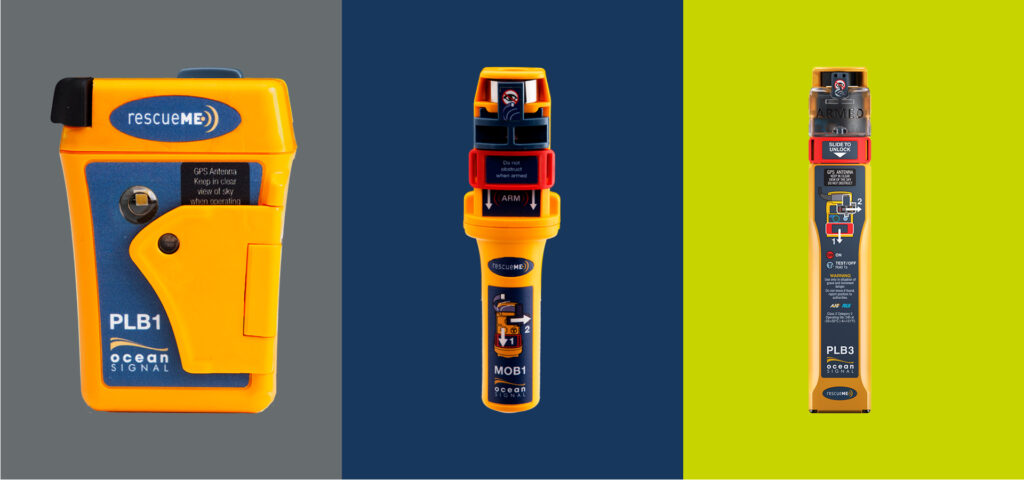LOOKING AT THE DIFFERENCE BETWEEN THE AIS-OPERATED MOB1, THE SATELLITE SYSTEM’S PLB1, AND PLB3 WITH AIS INTEGRATION, ALL SUPPLIED BY OCEAN SAFETY
Offshore skippers and crew are increasingly investing in a handheld beacon to keep about their person when they are at sea usually fitted to a lifejacket. This means that if you fall overboard or your yacht finds itself in a life-threatening situation the beacon, once activated, emits a signal to alert potential rescuers not just to your plight, but to your exact position too, so you can be located quickly.
There are a number of different personal locator systems on the market but they mostly work using one of two alert systems. Ocean Safety provides a choice, offering the best product for each system, namely the Ocean Signal RescueME MOB1, Ocean Signal RescueMe PLB1, and the Ocean Signal RescueMe PLB3. The MOB1 belongs to the family of AIS beacons while the PLB1 sends alerts to a satellite system operated by Cospas Sarsat. A PLB3 bridges the gap between the two, introducing AIS Functionaility, RLS (Return Link Service) technology and NFC Capability within one 406 MHz PLB.
Let’s look at these in a little more detail.
Ocean Safety’s Ocean Signal RescueME MOB1
When you fall in the water with the MOB1, once activated will send an alert to the AIS receiver on board the vessel you have been separated from. It will also send the alert over a distance of up to 5 miles to AIS receivers on other vessels in your yacht’s vicinity. Most modern professional lifejackets are now designed to accommodate the MOB1. It is also worth knowing that the MOB1 is the world’s smallest AIS MOB device but in all instances should be fitted by an approved service station to ensure that the fitting does not compromise the integrity of the lifejacket.
The benefit of the AIS system is that it communicates your location back to your own boat so the rest of you crew will immediately be aware of the incident and keep track of your position whilst the recovery is underway. Even in the most moderate of seas it is alarming how quickly a visual sighting of a person overboard can be lost.
Rapid alerting is also assisted by the MOB1’s ability to activate the DSC alarm on your vessel’s VHF, which makes sure your crew are alerted to the situation. The integrated GPS ensures precise location is sent to your vessel and any others that may be assisting. Plus an integrated strobe light ensures maximum visibility in low light conditions making it easier to spot the person in the water.
Ocean Safety’s Ocean Signal RescueME PLB1
Not dissimilar in size is Ocean Safety’s Ocean Signal PLB1. While it’s function is to similarly locate a sailor in distress the method of communication is slightly different. The PLB1, which, like the MOB1, also quickly starts transmitting when the crewmember hits the water, but this time at the press of a button. Unlike the MOB1 the PLB1 transmits via the COSPAS SARSAT satellite system operated and paid for by an international agreement. There’s no subscription to pay but you do need to register your device when you buy it so the rescue services know who they are dealing with and who your next of kin are. When activated the RescueME PLB1 transmits your position and your ID to a Rescue Coordination Centre via the satellite link. Rescue services nearest to the activated beacon location are promptly notified of your emergency and regularly advised of your current location to assist prompt rescue.
OCEAN SAFETY’S OCEAN SIGNAL RESCUEME PLB3
With the introduction of Automatic Identification System(AIS) functionality, Return Link Service(RLS)technology, and Near Field Communication(NFC) capabilities in one 406 MHz Personal Locator Beacon (PLB), the rescueME PLB3 represents a significant step forward in the evolution of PLB’s. The merging of 406MHz and AIS distress messaging effectively pairs both global and local rescue, thereby maximizing access to the most effective rescue resources available.
In addition, NFC capability provides users with the world’s first smartphone-connected PLB and the all-new Return Link Service feature provides users with the comfort in knowing that their distress message has been received and their location detected by worldwide Search and Rescue personnel. As a leading innovator in life-saving products for both professional and recreational use, Ocean Signal is proud to offer the PLB3. As the world’s FIRST Personal Locator Beacon to include AIS and the world’s FIRST PLB to include NFC, there’s no need to justify why the PLB3 should be your FIRST choice
Choosing whether to carry an MOB1, PLB1, or PLB3 can be a matter of preference. The PLB is particularly valuable for use in remote areas where there may not be other vessels in close proximity. Equally it can bring outside help if the whole vessel is in distress. The MOB1 is an important way to protect the safety of individual crew members with the help of their own fellow sailors and nearby vessels with the need to launch a major search and rescue operation being only a last resort.

